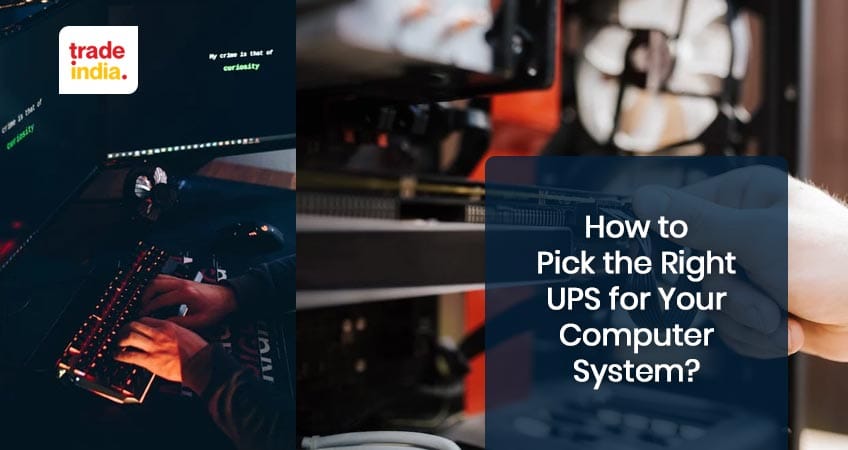How to Pick the Right UPS for Your Computer System?

UPS, which stands for "uninterruptible power supply," is a piece of hardware that stores energy in case of a power failure (blackout), power fluctuation (brownout), or power surge. A backup power supply (UPS) keeps a computer running long enough for the user to save their work before the system shuts down in the case of a power outage. In the event of a brief power loss, the computer will continue to function normally. APC's battery backup power strip is seen here.
Steps to buy the right computer UPS
1:- Types of UPS
To choose the right type of UPS for your computer system, it is important to know the type of UPS that your computer connects. Let’s see the top three types of UPS:
- Standby/Offline/Battery Backup
Offline UPS, often called as standby ups or battery backup, is a cost-effective option. Power abnormalities and brief outages can be avoided with the help of a good offline UPS system's rapid transition to battery power. An offline UPS can prevent severe power fluctuations, but it can't prevent small fluctuations or surges.
An offline UPS's reliability is determined by the range of input voltages it can operate on before needing to switch to battery power. Range reduces battery drain and increases backup time when the power goes off. UPS battery life decreases with each battery backup.
- Line-Interactive
Line-interactive UPSs provide power conditioning and battery backup. This device works well in locations with power fluctuations but few outages. Line-interactive UPS systems tolerate large input voltage swings before switching to battery backup.
Beyond battery backup, line-interactive UPS gives significantly greater control over power fluctuations that offline solutions. The main benefit of line-interactive UPS is the voltage boost circuitry and the range of input voltage that UPS accepts. More range means more protection.
- Online Double Conversion
AC generation is clean and reliable. But during transmission and distribution, it is prone to voltage sags, spikes and full failure that may cause data loss, stop computer operations, and damage equipment. Most of ups manufacturers suggest only online double conversion technology protects important IT loads from all these power issues, delivering the best network security.
Because incoming power is converted to DC and then back to AC, online UPS systems are also termed double conversion. AC-DC/DC-AC design isolates load from main supply anomalies.
2:- Features that you want
Now that you know how to measure for and evaluate the UPS's most fundamental components, we can move on to the more advanced options you should think about.
- User-replaceable batteries: Does it come with a battery pack, and if so, how much do replacements cost? There is a finite lifespan for UPS batteries. In general, an uninterruptible power supply (UPS) battery will last between three and five years. When the battery dies, as it inevitably will, you'll need to replace it with fresh batteries or get a completely new device.
- Noise/Fans: Most compact UPS systems lack cooling fans. Larger ones usually do, so before you buy, it's a good idea to check internet reviews and forums to see whether the fans really are as silent as the company promises.
- Displays: You might not give much thought to whether or not your UPS has a screen, and you might not even need one. Older models and cheaper later models do not have screens. As a result, the unit's feedback is restricted to either the USB/serial cord or, more annoyance, sounds.
- Cable Filters: Make sure the ups for the computer have surge protected/filtered connectors for your Ethernet and Coax connections if you want to use it with your cable modem and router, for example.
- Number of Outlets: In most cases, an uninterruptible power supply (UPS) will have both battery-powered and non-battery-powered outlets available for use. Check that you have access to enough power outlets.
- Supplementary Software/OS Compatibility: A power protection system (UPS) is more than just a power strip with a battery pack connected. An interface for communicating with the connected computer is an essential feature of any UPS worth its salt.
3:- Terminal Protectors
In the event of an electrical shock or accident, terminal protectors will prevent any damage. Home UPS is built with sturdy tubular plates for durability and longevity. The Home UPS's low antimony alloy frame adds to its affordability and ease of maintenance.
4:- Vent Plugs
Vent plugs in an uninterruptible power supply (UPS) are there to keep the gas pressure in the battery at a safe level. It is well suited to regions that experience frequent and lengthy power outages because of its high overcharge tolerance and deep discharge capabilities. One of the finest UPS for a computer is the APC Home UPS, which can be purchased from Schneider Electric and features a guarantee of 18 months.
5:- Warranty
One of the most essential features of a UPS is an extended warranty period. A longer warranty with affordable computer ups price, from 12 to 48 months, usually means the product is of greater quality and will last longer.
6:- Remote Power Management
Any network or server UPS with a network card port may be turned into a networked managed device with the addition of a network management card. Anywhere you have internet access, you may check your energy use and restart a device that isn't responding.
With the included network card, you can manage anything using SNMP, the web, SSH, or telnet. An Ethernet connector on the card enables remote access to the UPS's sophisticated monitoring, control, and alerting functions.
In addition, the card may be paired with additional sensors for remote monitoring of conditions including temperature, humidity, and contact closure. A network card is sometimes included in network/server UPS systems.
7:- Power Supply
The overall electrical load and the desired runtime after power loss are the two most crucial factors to think about when selecting an uninterruptible power supply (UPS). Your critical devices and your ability to save work and securely shut down your system should both be maintained by the UPS's power supply.
8:- Running time
A UPS's runtime is the amount of time that it can continue to power connected devices from its battery supply after the main power source has failed. The amount of power used by the UPS is proportional to the number of connected systems.
The longer the UPS can keep things running without being recharged, the less power it can supply. It is advised that the best ups for computers be purchased with an output watt capacity that is 20–25% more than the total wattage of the devices to which it will be connected. UPS watts calculator can let you figure out your entire power consumption.
It is recommended to first determine how much time you will have before the battery has to be recharged, and then to consider the brand and available features. UPS offers fantastic customization choices and has been dependable for years.
Also, read: Top 10 Desktop Computer Manufacturers in India
9:- LCD Screen
Accessing the UPS system's more complex capabilities may be possible without the need of a computer if an LCD panel is installed. Details like input voltage and battery capacity may be shown. Commonly, the LCD will have a backlight. Be sure the UPS system's illumination can be turned down if you intend to use it in a completely dark environment, such as a home theater.
Conclusion
Find out why it is recognized as one of the largest producers and distributors of electrical components and devices around the world. It is an online store that caters to all of your electrical needs and provides solutions in a single location. In addition to uninterruptible power supplies (UPS) for desktop computers, the provider gives customers access to deals on MCCBs, RCBs, and a broad variety of other electrical components at prices that are accessible.
A UPS is not in any way affordable, despite the fact that we strongly advise you to purchase the UPS unit that precisely meets your requirements and includes all of the functions that you desire. However, there is no way to achieve such a perfect fit without first performing the calculations that were outlined in the previous section and then engaging in some thorough price comparison. If, on the other hand, you are interested in safeguarding the financial commitment you have made to your computer system, you should go out and get one as soon as possible.
FAQs: UPS
Q. Which UPS is best for a PC?
Ans. APC Back-UPS Pro BR1000G-IN, 1000VA / 600W, 230V UPS System is the best UPS for the PC. There is an easy-to-read LCD display on this UPS that shows vital information about the device's operation. Load and battery bar graphs are only two of the many available status indicators. The status of the battery, the power-saving mode, the AVR, any system faults, the input and output voltages, the mute switch, and more are all shown. This means you can keep your online identity protected.
Q. How long will a computer’s ups last?
Ans. Most UPS batteries have a three- to five-year lifetime when operated in temperatures between 68 and 77 degrees Fahrenheit.
Q. Does using computers increase electricity bill?
Ans. Absolutely not (probably). On the other hand, you cannot expand your storage space. Like watts (W), kilovolt-amperes (kVA) is a measurement of perceived power (Watt).
Q. Is UPS necessary for PC?
Ans. Yes, UPS is necessary for the PC because you should take precautions to safeguard your computer and any work you may have done on it against the possibility of a power outage.
